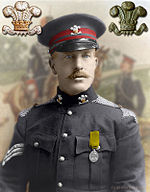| Denbighshire Hussars | |
|---|---|
 Denbighshire Hussars Sergeant, 1907 | |
| Active | 1794 - 1921 |
| Country | United Kingdom |
| Branch | British Army |
| Type | Yeomanry |
| Role | Yeomanry Cavalry |
| Size | One Regiment |
| Battle honours |
World War I Second Battle of Gaza Third Battle of Gaza Battle of Beersheba Battle of Epehy |
The Denbighshire Hussars was a unit of the British Army from 1794 to 1921. It saw service in the First World War before being merged into a unit of the Royal Artillery.
Early history[]
Formed as a volunteer cavalry unit in 1794 during the French Revolutionary Wars, the Regiment became the Denbighshire Hussars in 1876. It trained at Hightown barracks in Wrexham for the Boer War and the two World Wars.[1] In 1830 it was used to quell colliery workers in Rhosllannerchrugog. The colliery workers were angered by the truck shop system that forced them to spend their wages in shops owned by their employers. They planned to destroy a truck shop owned by the British Ironworks Company. The Regiment was ordered out on patrol to 'terrify the mob.'[1] At an incident in Rhosllannerchrugog, known as the Battle of Cinder Hill, overzealous troops had to be brought under control after a demonstrator threw a firework at the soldiers.[1] In 1911 the Regiment had the honour of being the escort to the Prince of Wales to his Investiture at Caernarfon Castle.[1]
World War I[]
The Denbighshire Hussars, like other Yeomanry Regiments formed second and third line regiments in September 1914, the 2/1st Denbighshire Hussars remained in the United Kingdom throughout the war and were converted into a cyclist unit in 1916. The 3/1st Denbighshire Hussars was formed in 1915 and also remained in the United Kingdom before being disbanded in 1917.
The 1/1st Denbighshire Hussars in 1914, were in the Welsh Border Mounted Brigade, which in September 1914 was attached to the 1st Mounted Division. In 1916 the 1/1st, together with the rest of the Brigade and the South Wales Mounted Brigade, became a dismounted unit. In November 1915 it became a dismounted unit and moved to Egypt, forming the 4th Dismounted Brigade.
In February 1917 it went through another change. This time the unit was re-roled as infantry to become the 24th (Denbighshire Yeomanry) Battalion, Royal Welsh Fusiliers, attached to the 231st Brigade, 74th (Yeomanry) Division. As part of the 74th (Yeomanry) Division, the Battalion/Regiment was involved in the Second and Third Battles of Gaza, the Battle of Beersheba and the Battle of Epehy.[2][3]
Amalgamation[]
After World War I, it had become clear that cavalry was obsolete and in 1922 it was announced that some Yeomanry Regiments were to become Royal Artillery units. The Denbighshire Yeomanry were one of these Regiments; it was re-roled as a medium artillery formation, and amalgamated with the 61st Medium Brigade Royal Garrison Artillery (the former Carnarvonshire Artillery Volunteers), to form 61 Medium Regiment R.A. (Caernarvon and Denbigh Yeomanry). In 1939 it formed a duplicate unit, 69 Medium Regiment R.A. (Caernarvon & Denbigh Yeomanry).[3][4] It would see service in France during the phoney war (1939-1940); after the Dunkirk evacuation, it would remain in the United Kingdom until returning to Europe in June 1944 with 21st Army Group.[5]
In 1947 the regiment reformed as an artillery formation as 361st (Carnarvonshire and Denbigh Yeomanry) Medium Regiment. In 1956 this was merged with the 384th Light Regiment (formerly 5th Battalion, Royal Welch Fusiliers) to become the 372nd (Flintshire and Denbighshire Yeomanry) Regiment. The Regiment effectively ceased to exist in 1968, although it continued in name as a cadre until it was amalgamated in 1971 with the Welsh Volunteers to become the 3rd (V) Bn Royal Welch Fusiliers, in which form its lineage was continued until 1999 as a unit of the Territorial Army. In 1969, Cadre members formed part of the military route-lining party for the Investiture of the Prince of Wales at Caernarfon.[2][3]
References[]
- ↑ 1.0 1.1 1.2 1.3 "wrexham.gov". http://www.wrexham.gov.uk/english/heritage/virtual_gallery/jacket.htm.
- ↑ 2.0 2.1 "The Denbighshire (Hussars) Yeomanry" Land Forces of the British Empire 18 June 2006 archived from the original on 20 December 2007 http://web.archive.org/web/20071220013400/www.regiments.org/regiments/uk/volmil-wales/vcav/flintden.htm. Retrieved 20 May 2010.
- ↑ 3.0 3.1 3.2 "Carnarvonshire & Anglesey Artillery Volunteers, Royal Artillery (Territorials) 1860-1922" Land Forces of the British Empire 10 June 2006 archived from the original on 29 November 2007 http://web.archive.org/web/20071129033234/www.regiments.org/regiments/uk/volmil-wales/varty/carnangl.htm. Retrieved 20 May 2010.
- ↑ "ra39-45". http://www.ra39-45.pwp.blueyonder.co.uk/yeo/index.html.
- ↑ "ra39-45". http://www.ra39-45.pwp.blueyonder.co.uk/med/page25.html.
The original article can be found at Denbighshire Hussars and the edit history here.